A multi-institutional team of scientists from the Galapagos Science Center, Georgia Aquarium, MigraMar, the Galapagos Whale Shark Project and the Galapagos National Park Directorate recently concluded a groundbreaking research expedition to tag and track several key migratory marine species in the Galapagos Marine Reserve. The expedition was supported by the Galapagos Conservation Trust, Rufford Foundation, PADI Foundation and the Royal Society.
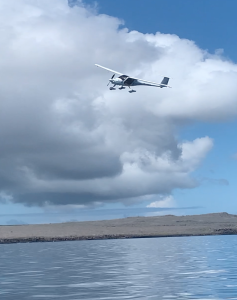
Working onboard the local fishing vessel Yualka II, over a two-week period, they placed satellite tags on scalloped hammerhead sharks, blue sharks and yellowfin tuna, as part of a larger study to establish their movement patterns and the role of marine protected areas in their conservation. “We know so little about blue shark movements in this region, and yet they are one of the most commonly caught shark species in the mainland-based longline fishery that operates just outside the border of the marine reserve,” explained expedition member Angela Palomino, from the Galapagos Science Center.
However, the main target of the trip was to find the elusive whale sharks. Galapagos is globally renowned for its aggregation of large female whale sharks at the northernmost Darwin Island from June through November. “We’ve been tracking the sharks there for a decade,” said Sofía Green, a researcher with the Galapagos Whale Shark Project and MigraMar. “They tend to spend only a day or two at Darwin, before heading out west into the open ocean, and then turning around and traveling to the shelf break of Ecuador and northern Peru at the end of the year. But where are they before they arrive at Darwin?”
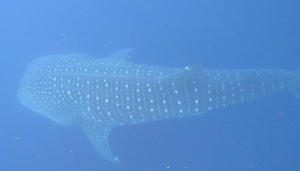
Whale sharks are reported around the southern islands early in the year, leading the team to speculate that this area is part of a migratory loop, with the sharks moving up through the archipelago as the year progresses. “We had a big breakthrough in 2017, when our pilots discovered 15 whale sharks close to the surface while on an aerial patrol to the south of Isabela,” said Harry Reyes, Head of Ecosystems at the Galapagos National Park Directorate. The researchers were able to team up with Julio Vizuete, from “Ecuador Bajo Mis Alas” (Ecuador Under My Wings) and use his ultralight airplane to search for whale sharks around the southern islands and seamounts. On the first day of the expedition, the team encountered a whale shark at a seamount not far from San Cristobal. “She was close to the surface, so we were able to tag her and take swabs from her skin and around her gills, as part of a wider study to understand how their microbiome changes in different environments,” said Cameron Perry, a PhD student at Georgia Aquarium and Georgia Institute of Technology.
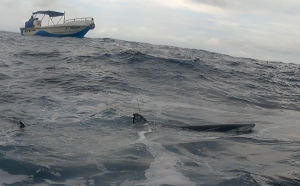
With aerial support, the team had a further nine whale shark encounters and were able to place five satellite tags, all on large females. “Whale sharks are mostly solitary, and when they form feeding aggregations at coastal locations, these are dominated by smaller individuals. Offshore locations are challenging to study, but we’ve been supporting work here in Galapagos and at other offshore islands such as St. Helena in the Atlantic, for several years. This is where we find adults and, in particular in Galapagos, large females. I would not be surprised if the females we tagged on this trip eventually made their way up to Darwin later in the year. We are hopefully a step nearer to identifying the full migratory loop,” explained Dr. Kady Lyons, Research Scientist at Georgia Aquarium.
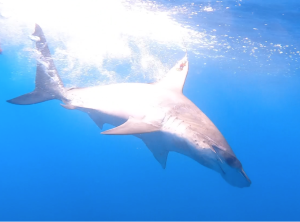
“The first few days of tracking showed that the animals for the most part associated with the platform break, but they have now started to disperse to the south of the islands, outside the borders of the marine reserve,” said Elaine Alberts, Project Coordinator at Georgia Aquarium.
“After two weeks at sea, we are now tracking four critically endangered scalloped hammerhead sharks, four blue sharks, four yellowfin tuna and five whale sharks in near-real time. This was years in the making,” said Dr. Alex Hearn (USFQ/MigraMar/GSC), expedition leader. “Our aim was proof of concept – are we able to detect whale sharks from the air, and intercept them with a speedboat? A single tagged whale shark would have been a success – five individuals is simply amazing. We are already learning so much from their initial movements.”
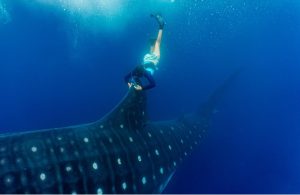
The expedition is the first step in a wider project with Universidad San Francisco de Quito and partners to monitor and track marine megafauna from the air, in the Galapagos Marine Reserve, the newly-created Hermandad Reserve and along the coastal waters of mainland Ecuador.

The Galapagos Science Center (GSC), located in Puerto Baquerizo Moreno in San Cristóbal-Galapagos, is a joint initiative between the San Francisco de Quito University (USFQ) and the University of North Carolina at Chapel Hill (UNC) created in 2011. The GSC is a hub to coordinate scientific research projects between local, national, and international scientists to benefit the Galapagos Islands and the world of science. The GSC aims at identifying the proper balance between the natural environment and the people who live in and visit the Galapagos. This work requires scientists from different disciplines. In this sense, the GSC houses in more than 13 research areas based on its three fundamental axes: interdisciplinary scientific research, education through science, and community outreach. www.galapagosscience.org
Georgia Aquarium is a leading 501(c)(3) non-profit organization located in Atlanta, Ga. that is Certified Humane by the American Humane Association and accredited by the Alliance of Marine Mammal Parks and Aquariums and the Association of Zoos and Aquariums. Georgia Aquarium is committed to working on behalf of all marine life through education, preservation, exceptional animal care, and research across the globe. Georgia Aquarium continues its mission each day to inspire, educate, and entertain its millions of guests about the aquatic biodiversity throughout the world through its hundreds of exhibits and tens of thousands of animals across its nine major galleries. For more information, visit www.georgiaaquarium.org.
The Galapagos whale shark project was created in 2011 and founded as a non-profit organization in 2021, registered in Chicago, Il, and working in the Galapagos Archipelago. Through research and education the project aims to understand the natural history of the whale shark (Rhincodon typus) , their spatial and seasonal patterns and behaviour as well as abundance and distribution of whale sharks at a local, regional and global level. The GWSP aims to promote the amplification of marine protected areas and raise global awareness of whale sharks as charismatic ambassadors for marine conservation. For more information visit galapagoswhaleshark.org
MigraMar was founded in 2006 as a network of scientists dedicated to research and conservation of migratory marine species in the Eastern Pacific. Their mission is to provide the necessary technical advice for the conservation of the migratory marine species in the Eastern Pacific. The network is made up of 22 researchers belonging to universities, government agencies and non-profit organizations in different parts of the American continent. MigraMar provides scientific information regarding migratory patterns of marine species, evaluates and forecasts the state of populations, in order to increase knowledge about these, understand the role they play in the ecosystem, and how best to preserve them. www.migramar.org
Galapagos Conservation Trust (GCT) is the only UK registered charity to focus solely on the conservation of the Galapagos Islands, one of the most unique and ecologically important, but vulnerable, areas in the world. With over 25 years of experience supporting impactful conservation programmes across the Archipelago, we partner with Ecuadorian authorities, NGOs, local communities and leading scientists, both in Galapagos and worldwide. By raising funds and awareness in the UK, we are able to support and deliver projects in Galapagos and respond to key threats facing the Islands, focusing on restoring natural habitat, protecting threatened species and driving sustainable solutions, helping to contribute to the overall management of this unique ecosystem. galapagosconservation.org.uk
